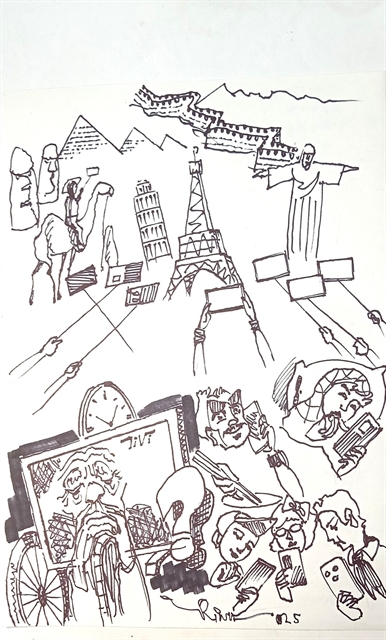You might still see gleaming TVs in stores, with curious shoppers standing nearby, but rarely making a purchase. They’re waiting for something revolutionary- a device that not only displays but also comprehends.

Illustration by Trịnh Lập
Thanh Nga
Once the undisputed star of the living room, the television was a proud symbol of prosperity and civilisation. Now, it quietly observes the world transform, overshadowed by the relentless swipes of smartphone screens.
As consumer habits evolve, televisions face a critical challenge: how to remain relevant in an era dominated by digital technology and artificial intelligence, lest they become mere decorations in our homes.
There was a time when any family fortunate enough to own a television set felt an immense pride - an emotion that’s difficult to convey in words today. In the 70s and 80s, a black-and-white National or Sony TV set from Japan was the ultimate luxury, a dream that many families aspired to achieve.
The price of such a device could rival a tael of gold - the most cherished asset of a household. Back then, a television was more than just a gadget; it was a beacon of wealth and modernity, a subtle marker of influence within the community.
I remember Mr Mạch’s home in our residential area, where the black-and-white Sony TV served as the magnet of the neighbourhood. Every evening, nearly everyone gathered there to watch, drawn not just from our community but also from surrounding areas. Children were cautioned not to touch the delicate antenna or smear the screen, while adults sat in rapt attention, as if absorbing a solemn speech.
We kids were enchanted by shows like Những bông hoa nhỏ (Little Flowers) and the thrilling escapades of Tây du ký (Journey to the West), memorising every frame and voiceover that flickered across that black-and-white screen.
Television programming wasn’t available around the clock as it is now; there were quiet moments when no shows aired. To fill the silence, channels occasionally showcased serene images of the homeland, accompanied by soothing instrumental music. Some stations even featured classical pieces that, as a curious country child, I simply labelled as "pretty music".
Then came the era of colour TV. Each vibrant splash of red and blue left me in awe, the bright programme titles seemed to dance before my eyes. The market evolved rapidly - from convex screens to flat displays and then to LED. Finally, smart TVs emerged, capable of connecting to the internet, accessing YouTube and responding to voice commands.
What was once a luxury has become commonplace. From townhouses to student dorms, TVs are now accessible to all, often priced at just a few million đồng.
Yet, with this accessibility comes a dilemma: as televisions become ubiquitous, they risk losing their significance in modern homes.
The days when families gathered to watch a programme are fading into memory. Today, people are glued to their own smartphones, children are addicted to TikTok and YouTube Kids. The TV remains in the living room, often left on merely for background noise.
Market experts have noted a significant decline in TV consumption over the past three years, particularly among large and mid-range models. Electronics stores are now burdened with rising inventories, and during football seasons or holidays, discounts can soar to a staggering 50-70 per cent, sometimes making TVs as affordable as regular smartphones.
Yet, the issue isn’t just about price; it’s the diminishing role of TVs in our lives, overshadowed by the allure of personal mobile devices. Each family may own 3-4 phones, but often maintains just one TV. Children today don’t wait for scheduled cartoons; a universe of entertainment is just a click away on their devices.
Shifting consumer behaviour has led to new technological demands. Today’s viewers want TVs that interact: identifying users, recommending personalised content and integrating seamlessly with smart home ecosystems. If a TV isn’t smart, it risks being left behind.
What remains of a device that was once the focal point of family life? In an age dominated by big data and AI, the television must redefine itself as the hub of the digital home.
You might still see gleaming TVs in stores, with curious shoppers standing nearby, but rarely making a purchase. They’re waiting for something revolutionary – a device that not only displays but also comprehends.
As we stand at the door of a new digital era, the future of television hangs in the balance. To reclaim its status as a central fixture in our homes, the TV must evolve beyond mere entertainment. It must become an intuitive companion that adapts to our needs, preferences, and emotional states. By embracing innovation and integrating seamlessly into our increasingly connected lives, the television can once again shine as a symbol of modernity and connection.
And if it can learn to understand us on a deeper level, perhaps the day will come when the TV is not just a passive observer, but an active participant in our daily lives – transforming from an object into a true friend that enhances our experiences and enriches our homes. VNS